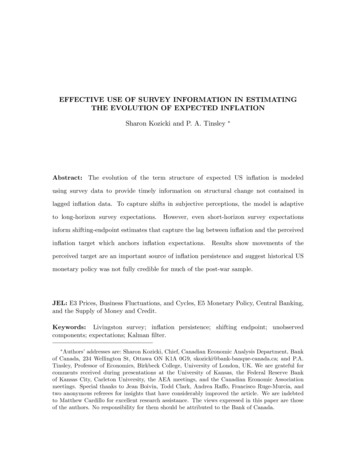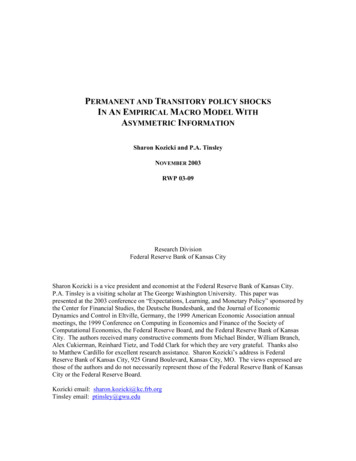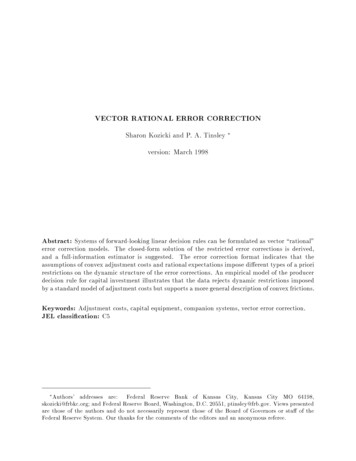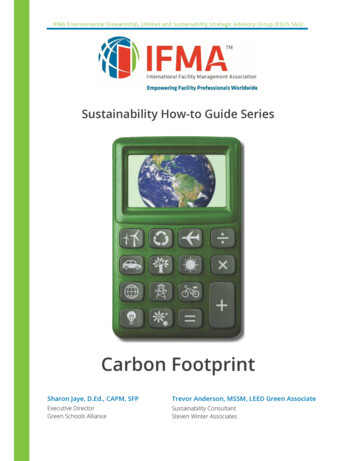
Transcription
EFFECTIVE USE OF SURVEY INFORMATION IN ESTIMATINGTHE EVOLUTION OF EXPECTED INFLATIONSharon Kozicki and P. A. TinsleyAbstract: The evolution of the term structure of expected US in‡ation is modeledusing survey data to provide timely information on structural change not contained inlagged in‡ation data. To capture shifts in subjective perceptions, the model is adaptiveto long-horizon survey expectations.However, even short-horizon survey expectationsinform shifting-endpoint estimates that capture the lag between in‡ation and the perceivedin‡ation target which anchors in‡ation expectations.Results show movements of theperceived target are an important source of in‡ation persistence and suggest historical USmonetary policy was not fully credible for much of the post-war sample.JEL: E3 Prices, Business Fluctuations, and Cycles, E5 Monetary Policy, Central Banking,and the Supply of Money and Credit.Keywords: Livingston survey; in‡ation persistence; shifting endpoint; unobservedcomponents; expectations; Kalman lter.Authors’addresses are: Sharon Kozicki, Chief, Canadian Economic Analysis Department, Bankof Canada, 234 Wellington St, Ottawa ON K1A 0G9, skozicki@bank-banque-canada.ca; and P.A.Tinsley, Professor of Economics, Birkbeck College, University of London, UK. We are grateful forcomments received during presentations at the University of Kansas, the Federal Reserve Bankof Kansas City, Carleton University, the AEA meetings, and the Canadian Economic Associationmeetings. Special thanks to Jean Boivin, Todd Clark, Andrea Ra o, Francisco Ruge-Murcia, andtwo anonymous referees for insights that have considerably improved the article. We are indebtedto Matthew Cardillo for excellent research assistance. The views expressed in this paper are thoseof the authors. No responsibility for them should be attributed to the Bank of Canada.
1IntroductionInformation on expected in‡ation at short and long horizons is key to assessing thecredibility of monetary policy, to examining how borrowing decisions of householdsand rms respond to shifts in real costs of debt, and to evaluating the expectedin‡ation response to monetary policy actions.Interestingly, as important asexpectations are in economic models, few studies explicitly model the behaviorof expectations using data on expectations.1Most likely this is because directobservations on market expectations of in‡ation are limited. In particular, as aconsequence of the incomplete sampling design of available surveys, only short timeseries are available for surveys that sample at quarterly frequencies or higher, andlengthy time series are available only for surveys of short-horizon forecasts, generallytwo- or four-quarter outlooks, and are often collected only at semiannual intervals.Survey limitations have generally led researchers to search for proxies of expectedin‡ation. One approach to construct expected in‡ation proxies follows Breedon andChadha (1997) and Söderlind and Svensson (1997) and extracts estimates of averageexpected in‡ation from data for nominal and indexed bond yields under restrictiveassumptions on term premiums and relative liquidity of the assets. However suchmeasures may be distorted, as discussed by Shen and Corning (2001) and Shen(2006) with reference to U.S. data, and Côté, Jacob, Nelmes, and Whittingham (1996)with reference to Canadian data. In particular, using Canadian data, Christensen,Dion, and Reid (2004) nd that the break-even in‡ation rate (BEIR), de ned as thedi erence between nominal and real return bond yields, is on average higher andmore variable than survey measures of expected in‡ation due to movements of risk1A few studies have used survey data directly. Examples include Roberts (1995 and 1997) andKozicki and Tinsley (2003).1
premiums and other factors not directly linked to in‡ation expectations.Another approach to proxy for expected in‡ation is to use forecasts fromreduced-form time-series models.Reduced-form time series models are popularspeci cations that are easy to use in multi-period forecasting exercises owing totheir linearity. They don’t require practitioners to take a stand on the underlyingstructural model, yet forecast relatively well over short horizons.2For example,Harvey (1988) forecasts in‡ation using an IMA(1,1) model to construct an expectedin‡ation series, and Laubach and Williams (2003) proxy in‡ation expectations withthe forecast of the four-quarter-ahead percentage change in the price index forpersonal consumption expenditures excluding food and energy generated from anAR(3) of in‡ation estimated over the prior 40 quarters. However, the ability of sucheconometric speci cations to e ectively accommodate structural change is limited.3By contrast, perceived structural change can immediately be incorporated intojudgement and will tend to immediately in‡uence expectations captured in surveymeasures. Each survey participant is implicitly providing information on his/herbeliefs about how the economy operates. While some participants may be reportingforecasts generated by unadjusted econometric models of the U.S. economy, most willincorporate judgement into their views about what they expect the future to bring.42McNees (1986) provides evidence that forecasts from Bayesian VARs are among the mostaccurate for forecasting several key US macroeconomic variables. That said, Wallis et al (1986,1987) nds that for UK data, VAR forecasts do not dominate model-based forecasts.3For instance, one approach to introducing the prospect for structural change is to allow allmodel coe cients to change. A simple approach taken by some researchers is to estimate VARs overmoving windows of data. As time progresses, earlier observations are discarded in favor of morerecent data, and model coe cients are reestimated. However, allowing all coe cients in VARs to betime-varying and use of rolling windows tend to lead to in-sample over tting problems and result inpoor out-of-sample forecasting performance.4Wallis (1989) reviews developments in macroeconomic forecasting, including a discussion ofjudgemental forecasts as well as structural and time-series models. Sims (2002) discusses forecastingexercises at several central banks, and o ers commentary on the role of “ ‘subjective’ forecastingbased on data analysis by sectoral ‘experts’.” See also Reifschneider, Stockton, and Wilcox (1997)2
Such forecasts tend to re‡ect information that is not well summarized by historicaldata or econometric equations. Examples include structural changes, such as changesin tax laws, perceived shifts in the long-run in‡ation goals of policy, or changes inperceptions of policy credibility.5Overall, the direct information on expectations as provided by survey data islikely superior to the econometric and yield-based proxies. Moreover, the superiorforecasting performance of surveys documented by Ang, Bekaert, and Wei (2007)and Chernov and Mueller (2008) lends support to the view that survey measuresare informative measures of expected in‡ation.6 Given this evidence on the forecastperformance of survey measures of expectations, it is interesting to note that thevalidity of proxies is generally based on theoretical arguments or on the ability of theproxies to forecast the underlying data. Comparisons of proxies to direct measures ofexpectations and empirical models of the expectations data themselves are rare.An important contribution of this paper is that it explicitly models the evolution ofexpected in‡ation. This modeling exercise con rms that subjective perceptions thatenter into surveys and in‡uence bond pricing di er signi cantly from forecasts impliedby standard econometric models, a result also evident in Kozicki and Tinsley (1998,2001a,b) and Kim and Orphanides (2005). The results also support the view thatdirect measures of expectations provide additional information beyond that containedin historical data on the economic variables themselves. An additional conclusion offor the use of judgement with econometric models in the Federal Reserve’s monetary policy process.5The possibility that survey participants may have more information about the economy thaneconometricians is also discussed by Kim (2008) and Ang, Bekaert, and Wei (2007). As noted in Kim(2008), the value-added of expected in‡ation surveys appears to be, in the context of forecastingin‡ation and bond yields, that surveys capture variations in perceived trend in‡ation that is notrevealed by simple time series models that reference the recent history of in‡ation.6Superior forecast performance of surveys of expected in‡ation provides strong evidence againstthe view expressed by some analysts that surveys may not be good measures because participantshave no incentives to provide their true expectations.3
the current paper is that it is not enough to just use survey data, they need tobe used in a model that is adaptive to their subjective information on long-horizonexpectations.The empirical speci cation in this paper jointly models the evolution of in‡ationand expected in‡ation under an assumption that expectations are model-consistent.This model is then used to construct a 50-year history of monthly measures ofexpected in‡ation and a term structure of expected CPI in‡ation for the UnitedStates to be consistent with the Livingston Survey data on expected in‡ation.7 Theconstructed measures of expected in‡ation (time t forecasts of in‡ation in t h)provide more frequent observations and a longer history of expected in‡ation byproviding consistent proxies for missing monthly observations (t) as well as over allhorizons (h). In addition, they provide good ts of survey observations when theyare available. The constructed measures can be used directly in empirical exerciseswithout the impediments, such as infrequent observations or short histories, that havelimited the use of direct measures of expectations.8One use of the constructions of long-horizon expected in‡ation is to examinethe historical credibility of monetary policy. In‡ation expectations are generallyanchored by private sector perceptions of the central bank’s in‡ation target. Bycomparing private sector long-horizon expectations of in‡ation to estimates of the“e ective” in‡ation target of U.S. monetary policy, the article provides informationon the historical credibility of monetary policy.7The objective of the current study is clari ed by use of a single survey: a term structure ofexpected CPI in‡ation consistent with economist expectations of in‡ation is produced.8A simple approach to expand histories of expected in‡ation might splice measures from di erentsources. Unfortunately, as noted by Chernov and Mueller (2008), there are systematic di erencesacross surveys— in concepts of in‡ation and agents being surveyed— implying that splicing measuresfrom various sources could lead to an inconsistent history of expected in‡ation with possiblesubsample biases. However, even in the absence of such possibilities, spliced series provide onlysmall improvements in the availability of expected in‡ation observations.4
The next section describes the Livingston Survey data on expected CPI in‡ationand the empirical model of the evolution of expected CPI in‡ation. The estimationuses a time-varying forecast methodology that assumes the unobserved cross-sectionof expectations formulated in a given period is consistent with recent in‡ation andavailable survey observations of expected in‡ation.9 The third section presents theempirical results. A state-space model is estimated and used to construct the monthlyterm structure of expected in‡ation, and robustness checks are provided. In thefourth section, the perceived in‡ation target implicit in the term structure of expectedin‡ation is compared with estimates of the central bank’s e ective in‡ation target andprovides strong evidence of asymmetry in expectations. While large di erences in the1980s suggest less than full credibility of low-in‡ation policy objectives at the time,more recent convergence signals an improvement in credibility. The article concludeswith nal comments in section ve.2A model of expected in‡ationLivingston Survey data on expected CPI in‡ation was chosen as the measure ofexpected in‡ation. One advantage of the Livingston Survey is that it has good forecastproperties compared with other survey measures of expected in‡ation (Chernov andMueller 2008). In addition, the Livingston Survey has been in existence for a muchlonger period of time, with surveys conducted in June and December starting in9The analysis in this paper is related to Chernov and Mueller (2008), which was developedindependently. The data and methodology of the current paper di er from that in Chernov andMueller, but most importantly, the two studies take di erent approaches to resolving systematicdi erences and biases across survey measures. In addition, the constructions in this paper start 15years earlier than those in Chernov and Mueller and are monthly rather than quarterly.5
1946.10 While the original survey provided information on short-horizon expectedin‡ation, the survey was expanded to also include 10-year in‡ation expectations in1990.The choice of modeling techniques was in‡uenced by data constraints and thedesire that expectations be model consistent— i.e., that the same data generatingmechanism be able to explain the dynamics of in‡ation and in‡ation expectations.A shifting-endpoint AR model (cast in the format of an unobserved componentsmodel) is used as the underlying data generating process (DGP) for monthly in‡ation.Under the assumption that expected in‡ation is consistent with this DGP, themulti-month (and year) horizon of the survey expectations implies that they arenonlinear functions of the AR parameters of the shifting-endpoint model. Expressionsfor in‡ation and expectations are set in a state space framework so that theunobserved perceived in‡ation target that anchors long-horizon expectations can beestimated. The state-space framework is well-suited to accommodate data limitations,including di erent observation frequencies of in‡ation (monthly) and survey data(semi-annually) as well as missing observations of long-horizon expectations for mostof the survey sample.2.1A shifting-endpoint AR model for in‡ationThe remainder of this section discusses the empirical model used to jointly modelin‡ation and expected in‡ation. For the application in this paper, the main di cultyencountered with most univariate and multivariate time series speci cations forin‡ation is that they tend to generate multiperiod forecasts that do not resemble10Documentation describing the Livingston Survey data is available on the Federal Reserve Bankof Philadelphia website at www.phil.frb.org. Croushore (1997) provides a description of the surveyand its history. Additional details on the Livingston Survey that are relevant for the current analysisare reviewed in section 3.6
available survey expectations (Kozicki and Tinsley 1998, 2001a, 2001b). In particular,long-horizon forecasts of in‡ation from mean-reverting AR speci cations are tooinsensitive to recent in‡ation, while those from models that impose unit rootrestrictions on in‡ation tend to be excessively sensitive to recent in‡ation. Thelatter suggests, for instance, that the Atkeson and Ohanian (2001) model, whichincorporates a unit root assumption and forecasts quite well at short horizons, wouldnot be as e ective at matching long-horizon in‡ation expectations. Consequently,this paper follows Kozicki and Tinsley (2001a, 2001b) by using a shifting-endpointvariant to approximate the implicit forecasting model for in‡ation that underliessurvey expectations. As will be shown, the shifting endpoint speci cation can be castin the format of the unobserved components model of Watson (1986).An advantage of the shifting-endpoint AR speci cation is that it can capturethe implications of structural change that lead to shifting long-horizon expectations.In addition, the AR structure is better suited to capturing the seasonality in theLivingston Survey data than IMA structures recommended by Stock and Watson(2007). Furthermore, as the model has relatively few parameters, it is less likely toover t the data than more complicated time series speci cations.The general in‡ation forecasting model with shifting in‡ation endpoints can berepresented ast 1wheret is in‡ation, zt01 zt 1[t 01 Czt::: 01 (It p 1 ]independent Normal with mean zero, I is a pof ones,1is a pC)0,t(t)1 01 1 t 1 ;(1)is an innovation assumed to bep identity matrix, is a p1 vector1 vector with a one in the rst element and remaining elements7
zero, and2CDe ne (L)Ltt 1.1 2L If all roots of (1expectation oft k6 166 1666 0666640 pL:::p 10:::001:::.00.0:::102p 1p3777777:77775, a polynomial in the lag operator L, where(L)) lie outside the unit circle, then the conditionalwill revert to the endpoint in the long run, i.e., limk!1 Et yt k (t) 111.The endpoint is the level to which in‡ation expectations eventually converge asthe forecast horizon is increased, conditional on a given information set. Intuitively,because the in‡ation endpoint is the conditional long-horizon forecast of in‡ationgenerated by the model, in a model of private sector expectations it can be thought ofas the private sector perception of the in‡ation target. Endpoints may shift accordingto information and beliefs at the time the forecast is made.12 The potential forendpoint shifts is an essential feature of the model of expectations as endpoint shiftscan accommodate the possibility of rapid reaction to structural change in surveyexpectations independent of recent movements in actual in‡ation.11Cases where roots of (1(L)) lie inside the unit circle, or where there are more than one unitroot are not considered in the current analysis. Note that if (1(L)) contains a unit root, thenthe endpoint is not independently identi ed. However, the limiting forecast continues to exist and(t)the endpoint can be calculated as 1 limk!1 01 C k zt , which is a moving average of order p ofin‡ation since in this case (1) 1 and 01 (I C) 0.12Evidence of shifts in the mean of in‡ation are provided by Garcia and Perron (1996). Theymodel in‡ation using a Markov switching speci cation with three states. As in their speci cation,parameters governing the speed of adjustment to long-run equilibrium (C) are assumed to beconstant in the current implementation, even with shifts in the description of long-run equilibrium.The implications and relevance of other generalizations to the forecasting system are left for futureresearch.8
In thinking about the dynamics of such long-horizon perceptions, note that ifsurvey participants could forecast future changes to their perceptions of the level atwhich in‡ation would stabilize, then such changes would be immediately incorporatedin their long-run perceptions. Consequently, changes in the endpoint should notbe forecastable. This property is captured by assuming that the endpoint evolvesaccording to a random walk:13(t 1)1More details on the properties oft (t)1(2) vt 1 :and vt will be provided with the state-spacedescription of the model in section 2.3.As described above, the shifting endpoint speci cation is a generalization of thelocal level model of Harvey (1989) and a version of the unobserved components modeldiscussed by Watson (1986).14 In particular, forc(L)(1(L)L)1andt 113A potential shortcoming with this approach is that expected in‡ation data is only availablesemi-annually. Since this data is expected to be the most informative about the unobservedshifting endpoint, it is possible that the interpolation algorithm may overly smooth higher frequency‡uctuations in the endpoint. However, lack of variation in more frequent (quarterly) 10-yearexpected in‡ation data as reported by the Survey of Professional Forecasters (SPF), suggests thatover-smoothing of endpoint variation is unlikely to be a major problem. The best anecdote relatesto the May 6, 2003 FOMC statement that referred to the “probability of an unwelcome substantialfall in in‡ation.” This statement may have led to an instantaneous upward adjustment in theperceived in‡ation target of monetary policy. However, quarterly-sampled median 10-year in‡ationexpectations as reported by the SPF did not vary from 2.5 percent throughout 2003 and meanexpectations only dropped by 0.5 basis points from the Q2 survey to the Q3 survey (and by 1 basispoint from the Q1 survey to the Q2 survey). While it is still possible that the endpoint exhibitedmore ‡uctuations at a frequency higher than a quarter, the available evidence suggests that such‡uctuations may be reversed within one quarter. But within-quarter reversals are inconsistentwith the random-walk structure of long-run expectations and are less likely to be relevant formacroeconomic analysis.14Unobserved components models are frequently used to model trend-cycle decompositions of realGDP (or GNP), as in Harvey (1985), Watson (1986), and Stock and Watson (1988).9
(t)1,the shifting endpoint speci cation can be rewritten as:t 1 t 1t 1 tcct 1 ct 1(3) vt 1(4)(L)(5)t 1 :In a recent study comparing several simple models, Stock and Watson (2007) foundthat a version of this speci cation withvariances oftc(L) 1 and time-varying estimates of theand vt performed remarkably well at forecasting quarterly GDP pricein‡ation. However, in their experience the IMA(1,1) speci cation was not e ectivewith quarterly CPI in‡ation and they did not evaluate the ability of their model to texpectations data. Moreover, the IMA(1,1) speci cation is too restrictive here owingto seasonality in the data, which a more general AR lag structure is able to e ectivelycapture.15The shifting endpoint speci cation shares features with other speci cationsproposed in the literature. For instance, the speci cation resembles the regressiveexpectations model of Figlewski and Wachtel (1981).They expressed expectedin‡ation as a weighted average of lagged in‡ation and long-run “normal” in‡ation,where the latter is de ned as the rate toward which in‡ation is expected to regress.However, whereas Figlewski and Wachtel assumed that the normal in‡ation rate15A more general speci cation of in‡ation might admit time-varying slopes in addition to atime-varying mean. While such a speci cation is relatively straightforward to introduce for in‡ation,the same is not true for multi-period survey expectations restricted to be consistent with thein‡ation DGP. In particular, time-varying slopes introduce several complications into the currentset-up. First, time-variation in the seasonal components may di er from time-variation that capturesnon-seasonal persistence, and distinguishing these two aspects may be important. Second, as will beshown in the next section, multi-period model-consistent expectations will be non-linear functionsof the time-varying slopes. Thus, the model of the multivariate system including expressions forin‡ation and multi-period expectations would be nonlinear in unobserved state variables (the slopes).While an interesting extension, such a generalization is beyond the scope of the state-space modelingenvironment of the current paper.10
was equal to a ve-year moving average of in‡ation, here the shifting endpoint istreated as an unobserved component to be estimated. Caskey (1985) estimateda time-varying constant in a more general learning model of Livingston 8-monthin‡ation expectations. Caskey’s learning model was a time-varying parameter modelthat included a constant and several macroeconomic variables. He interpreted aloose prior on the variance of the constant as evidence that the Livingston panelwere willing to quickly revise their beliefs about the constant, and concluded thatLivingston in‡ation forecasts could be explained as the product of a learning process.In other related work, Ang, Bekaert, and Wei (2007) found that a non-linearregime switching model with 2 regimes (allowing both the mean and lag coe cientsto switch) was a good forecasting speci cation for CPI in‡ation in the post-1995period. They attribute this advantage to a reduction in the persistence of in‡ation atthe end of the sample that can be captured through a regime switch. By allowing theendpoint to follow a random walk, the shifting-endpoint model can implicitly capturemore than two regimes. Shifts of the endpoint capture structural change and absorbsome of the persistence of in‡ation. Although AR parameters in C are constant,lower persistence is captured with a decrease in the relative importance of endpointmovements relative to in‡ation deviations for explaining in‡ation dynamics at theend of the sample.2.2Approximating Survey Expectations with ARExpectationsAs outlined earlier, survey data provides timely information on perceived economicstructural change. Because survey data on expectations includes judgemental viewsas well as the output of econometric forecasting models, such data is likely to11
immediately re‡ect perceptions that there have been structural shifts in the economy.The consequences for in‡ation expectations of these perceptions of structural shiftscan be extracted by linking the AR-based forecasting model to survey data on multiplehorizon expectations.Survey data report average in‡ation expectations over multiple periods. Let st k;tdenote the survey data for average expected in‡ation over the k periods ending int k, conditional on information available at t:1X SEk j 1 tkst k;t (6)t j ;where EtS signi es that expectations are made by survey participants and conditionalon information available at t.Multi-step forecasts of in‡ation based on the shifting-endpoint AR model are:Ett j 01 Et zt j 0 j1 C zt 01 (ICj)(t)1:(7)and conditional forecasts of average in‡ation over the next k periods are:(1 k)kXj 1Ett j 01 ((1 k)kXjC )zt j 101 (I((1 k)kXj 1C j ))(t)1:(8)Assuming the average in‡ation forecasts from the shifting-endpoint AR model of12
in‡ation provides an approximation of the survey expectation,st k;t (1 k)kXEt t jk;tj 101 ((1 k) kXjC )zt 01 (I((1 k)j 1wherek;t (1 k)PkSj 1 (Ett kkXC j ))j 1Ett k )(t)1 k;t(9)is approximation error. The approximationerror re‡ects di erences between the implicit forecasting model of the surveyparticipants and the shifting-endpoint AR model, and measurement error in surveydata, among other contributors. However, as both the survey data and the AR-basedaverage-in‡ation forecast are conditioned on information in t, the approximation errordoes not re‡ect di erences between actual in‡ation and predictions. Similarly, thereis no reason to expect that approximation errors will be serially correlated. The latteris in contrast to the di erence between actual average in‡ation over k periods andk-period predictions, which will in general follow an MA(k-1).162.3A state-space model of the in‡ation endpointEstimates of parameters of the model and a time-series for the unobserved endpointcan be obtained by representing the model in state space format and using the Kalman lter to provide linear least squares predictions of the unobserved endpoint.17 In statespace format, the endpoint is the unobserved state variable. As noted earlier, it isassumed to evolve according to a random walk:(t 1)1 (t)1 vt 1 :(10)16Hansen and Hodrick (1980) propose a methodology for examining restrictions on a k-step aheadforecasting equation.17State space representations, the Kalman lter, and approaches to estimating unobservedparameters are described in Harvey (1989) and Hamilton (1994).13
Innovations, vt , are distributed Normal(0; Q) with mean square error matrixV art ((t 1))1 Pt 1jt .Expressions for in‡ation and survey data constitute the measurement equations.Letting k1 ; k2 ; : : : kn denote the various horizons for which the survey data areavailable, and de ning yt 1 [st k1 ;t st k2 ;t : : : st kn ;t ]0 , the measurementt 1equations are:yt A0 zt1 H0(t)1(11) wt ;where2A066666 6666642H0and wt [t 1k1 ;tk2 ;t66666 666664:::01C3777j 1 C ) 77Pk2j 70((1 k)C)271j 17.7.75Pkn j01 ((1 kn )j 1 C )01 ((1 k1 )Pk101 (I01 (I01 (I01 (Ikn ;t ]0jC)Pk1377(1 k1 ) j 1 C ) 777Pk2(1 k2 ) j 1 C j ) 777.7.75Pkn j(1 kn ) j 1 C )j(12)is distributed as Normal(0; R), and vt and wtare independent of each other. The system described in (11) and (12) imposes thecross equations restrictions necessary to ensure that the survey forecasts incorporatemodel-consistent expectations.The structure of the covariance matrix, R, depends on the assumed relationshipsbetween in‡ation equation residuals (t 1 )and survey measurement errors (14k;t ),the
assumed relationships between measurement errors of surveys of di erent horizons,and variances. Results are presented for the case of R diagonal with the variances ofthe measurement errors assumed to be the same for any choice of ki , but with thevariance oft 1allowed to be di erent from the variance of measurement errors.Maximum likelihood estimation is described in Harvey (1989) and Hamilton(1994). Under normality of vt and wt , the log-likelihood function can be constructedusing the Kalman lter. With starting values for the unobserved state and it’s meansquare error, maximum likelihood techniques can be used to estimate parameters inA, H, Q, and R.To develop basic intuition for the model, it is useful to consider a simple shiftingendpoint AR(1) model of in‡ation, for 0 1, and a single k-period surveyexpectation. The measurement equations are:264wherek (1tst k;tk327 65 4) (k(13k75t 126 (1 4(13) 75)k(t)126 4tk;t375;(13))). Notice that in‡ation and expectations are weightedaverages of lagged in‡ation and the endpoint and that the weight on the endpointis smallest for in‡ation and increasing monotonically with forecast horizon k. Thissuggests an ordering to the data for each t with expectations bounded by in‡ationon one side and the unobserved endpoint on the other, with shorter-horizon (i.e.,smal
by standard econometric models, a result also evident in Kozicki and Tinsley (1998, 2001a,b) and Kim and Orphanides (2005). The results also support the view that direct measures of expectations provide additional information beyond that contained in historical data on the economic variables themselves. An additional conclusion of










